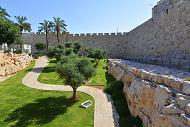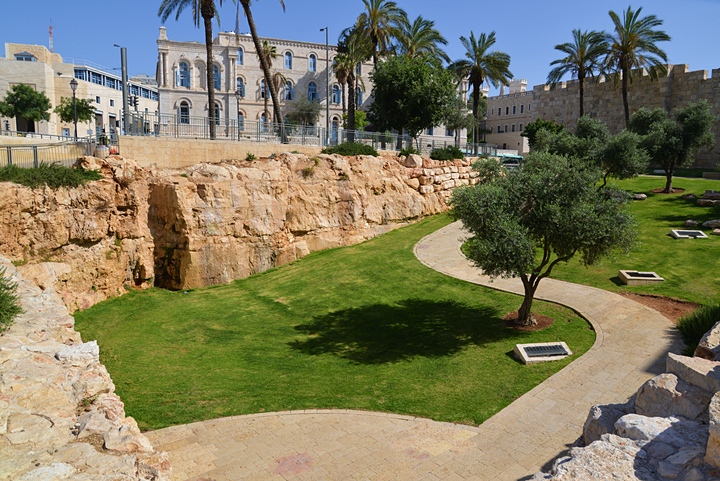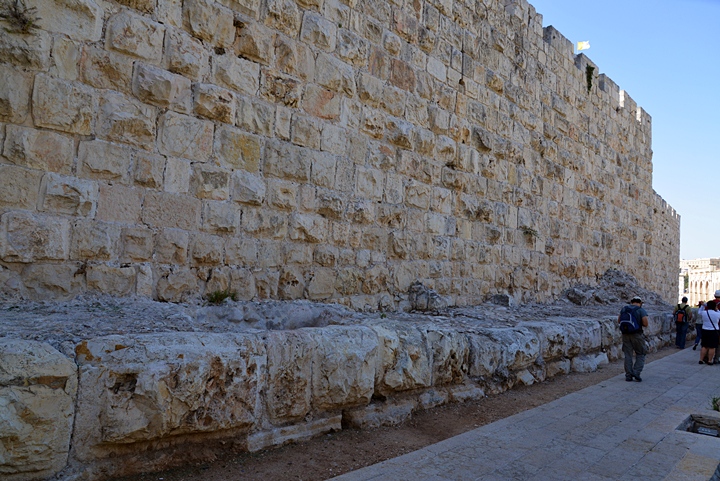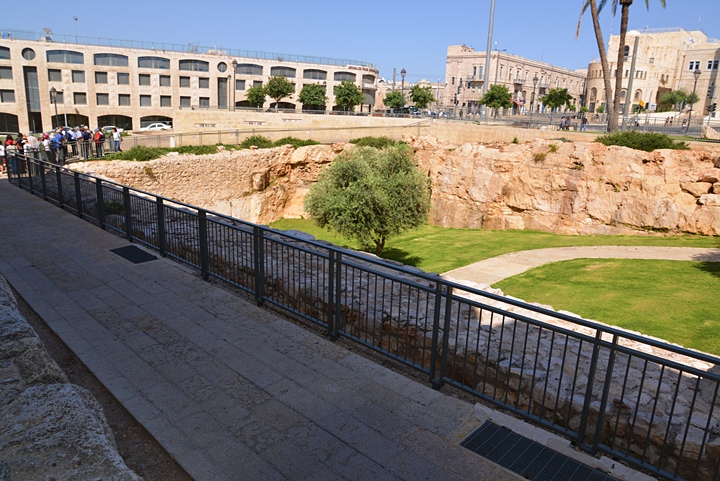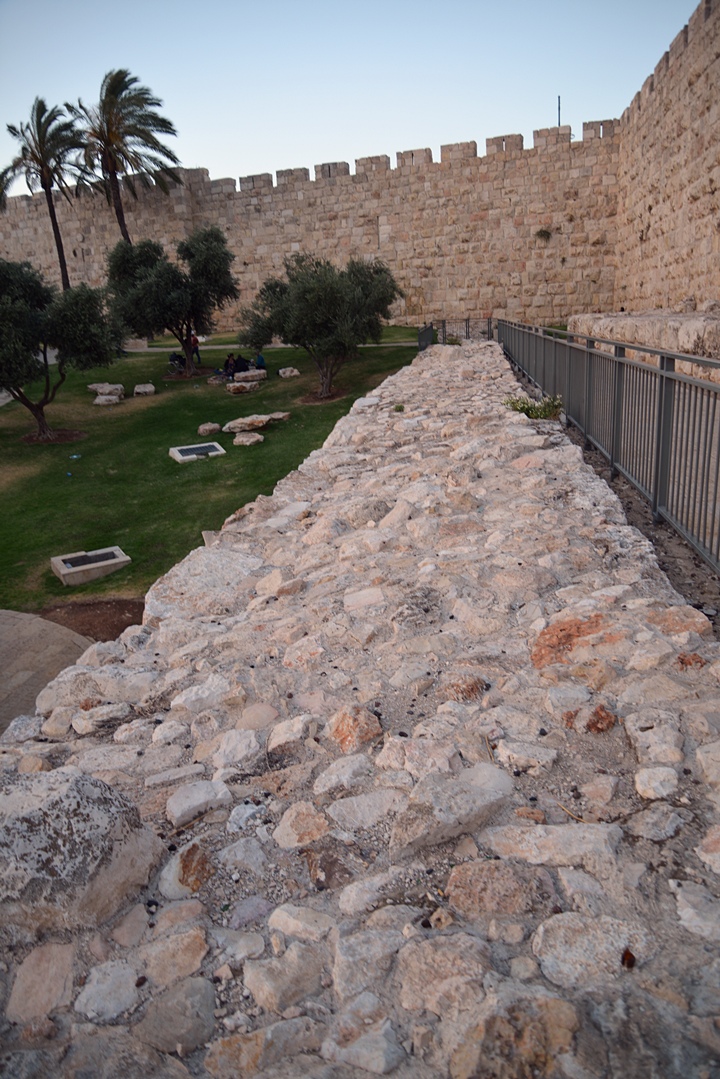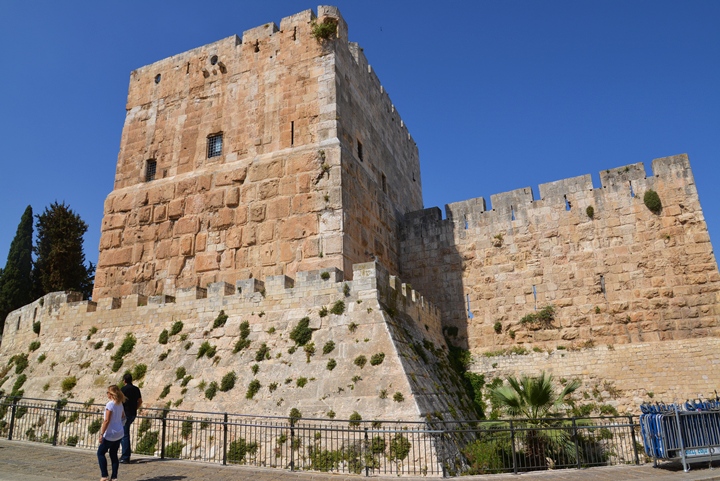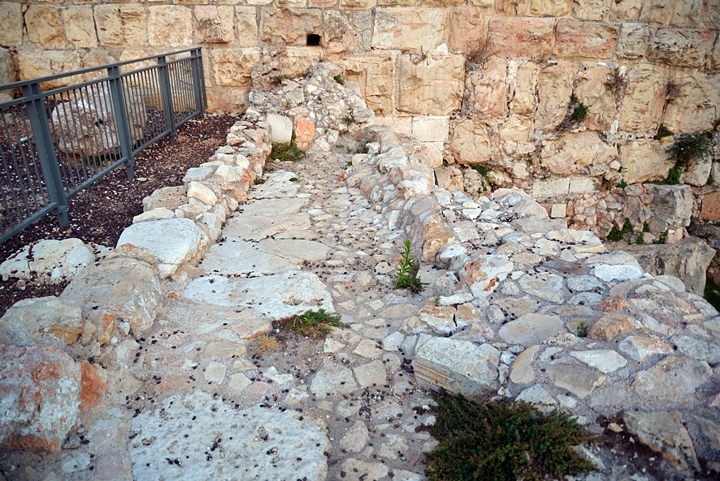Ruins of a fortress, dated to the Crusader period, located on the north west corner of the old city.
Home > Sites > Jerusalem > Tancred Fortress (Goliath, Burj Jalud)
Contents:
Background
Location
History
Photos
* General view
* Moat
* Foundations
* External wall
* Ayybid
Etymology
Links
References
Overview:
Ruins of a fortress, dated to the Crusader period, are located near the north west corner of the old city. It was one of the four towers located along the walls, and is named after the Crusader prince Tancred d’ Hauteville (1075-1112) of Normandy – a Crusader leader who conquered the city in 1099.
Location and Aerial map:
The north west corner of the old city is shown in this aerial map. Major points of interest are marked on it.
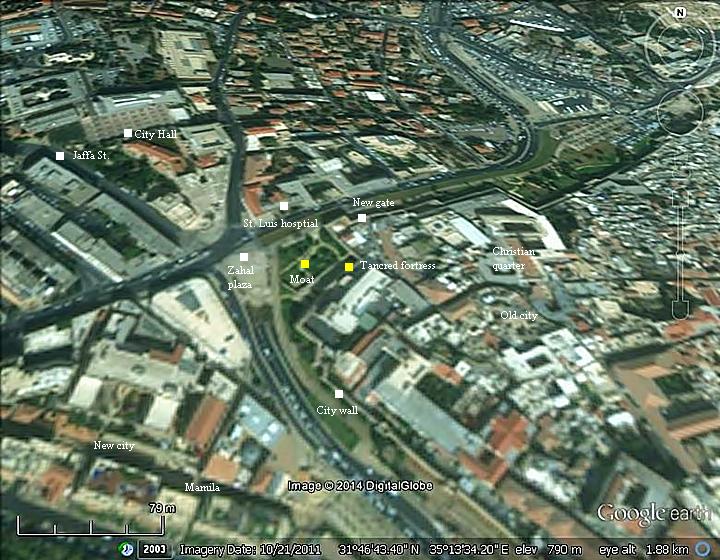
History:
-
Arab period
The Arabs conquered Jerusalem in 638 AD, and started to rebuild the city. One of the most remarkable constructions was the Dome of the Rock shrine, built in years 689-691 by the Umayyad Khalif Abdul-Malik ibn Marwan. The Umayyad caliphate rulers (661-750), the second of the four caliphates established after the death of Mohammed, also constructed a new wall around the city. For the first time the area of the walled city was extended to the north, where the present walls (built in the 16th Century) are currently standing.
-
Fatimids (969-1099)
The Goliath fortress (Burj Jalod, later named after Tancred Tower) is located on the northwest corner of the old city. It was one of the four fortresses located along the walls. The other fortresses were the Storks tower (Swan tower, Burj Laklak) on the northeast corner, another tower on the southwest corner, and the third in the southeast corner. The tower was built during the Fatimid Caliphate period (909-1171).
The Fatamids are mighty Arab Shi’ite rulers who originated from North Africa, and conquered the Holy Land in 969-977. As part of their fortifications of the city, they constructed a giant tower. Its formidable size may have be the source of its Arabic name – the “Goliath” (Jalud) tower. An additional explanation for the name is related to the Arab tradition that David killed Goliath at this place.
-
First Crusade (1096-1099)
The crusade to liberate the Holy Land and free Jerusalem was initiated in the great council meeting of Piacenza (March 1095), following an appeal from the Byzantine emperor Alexios I Komnenos to repel the Muslim (Seljuk) Turks conquests in the south Turkey. Pope Urban II (1042-1099) pushed for a military action to the Holy Lands at the council of Clermont (27 November 1095), with the primary goal to assist the Byzantine capitol of Constantinople. His speech at the council had a great influence, resulting in a call for arms throughout Europe to regain the Holy Lands under the name of God.
A large force of volunteers was assembled in France, Germany and Italy, estimated at 30,000-40,000, which included peasants, trained soldiers, knights and nobles. On their way to the east, the unorganized Crusader armies butchered the Jews in Germany and looted the villages along the way.
They fought their way to Constantinople, and finally reached the city a year later.
The campaign against the Seljuks took another year to complete (June 1098), ending with the conquest of the mighty city of Antioch after 8 months of siege (in June 1098 – see illustration below).
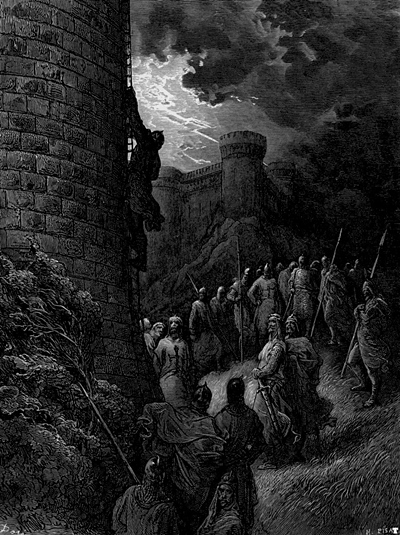
Siege of Antioch – Bohemond of Taranto climbs up the walls
– by Gustav Dore (French artist, 1832-1883)
The Crusade now focused on the secondary goal, which is to liberate Jerusalem. In the beginning of 1099 the Crusaders continued from Antioch towards Jerusalem, encountering little resistance along the coastal way. On June 7, 1099, three years after the military expedition started in Europe, the Crusaders finally approached the gates of Jerusalem. By then, their forces were reduced to about 10,000 soldiers.
The Crusaders first arrived to the site of Nebi Samuel, west of the city. Their first assault on the city took place a week later, on June 13. This attempt failed, as they lacked the machinery required to pierce the strong walls.
The Muslim Fatimid defenders chopped all the trees around the city. Therefore, the Crusaders waited until they secured a supply of wood which was required for building siege weapons, in order to breach the strong walls of Jerusalem. The arrival of the ships from Genoa to Jaffa on June 15 brought craftsman, tools and wood which were needed for building the ram and other siege installations.
The assault started on July 14, with the armies attacking the city from the north (headed by Godfrey), west (Tancred) and south (Raymond).
The Muslim defenders initially managed to repel the attacks with their use of catapults, throwing stones and burning pitch. Tancred attempted to capture the strong fortress on the west side of the city, known as the “Goliath” fortress (and later named after him). However, he could not capture it, but managed to breach the city walls at this site. 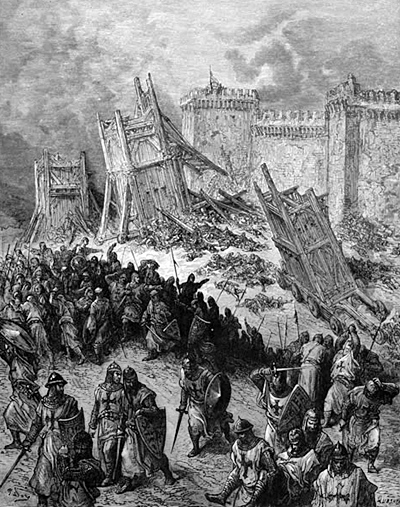
Attack on Jerusalem – the failed first day of the second assault
– by Gustav Dore (French artist, 1832-1883)
On midday of the second day of the siege (July 15) the Crusader’s ram managed to pierce a hole in the northern eastern wall adjacent to the Jewish quarter. The northern forces, headed by Godfrey de Bouillon, pushed into the breached walls In parallel, the southern forces broke into the city from Mount Zion. The attackers pushed into the city, beheading, burning and piercing with arrows all the inhabitants. Thus started a 3 day killing spree and sacking of the city. All the 40,000 inhabitants of the city – Jews and Muslims – were massacred, including men, women and children. This was a brutal conquest – according to chronicles of the period the Crusader horses “were up to their ankles in enemy blood” !.
The Egyptian Fatimid garrison, which was stationed in the tower of David, negotiated a truce and were allowed to leave the city unharmed, thus ending the campaign. The city was virtually empty from its population, except a few Orthodox Christians.
Following the capture of the city, which was the ultimate goal of the three years of the crusade, the joyful Crusaders celebrated their victory in the Church of Sepulcher, and established the Kingdom of Jerusalem.
Godfrey de Bouillon was elected the King of Jerusalem (with the title of the “defender of the Sepulcher) on July 22, but died a year later, succeeded by his brother Baldwin of Boulogne. Raymond left to Jericho, then continued to conquer other cities. Tancred captured the Galilee and was appointed to be the “Prince of Galilee” and received its lands. Tancred later received the regency of Antioch (1100), and remained there until his death at the age of 40 in 1112. Bohemond of Tarento, Tancred’s uncle, was the regent of Antioch before Tancred (1098-1100). The four leaders of the first Crusade are illustrated here.
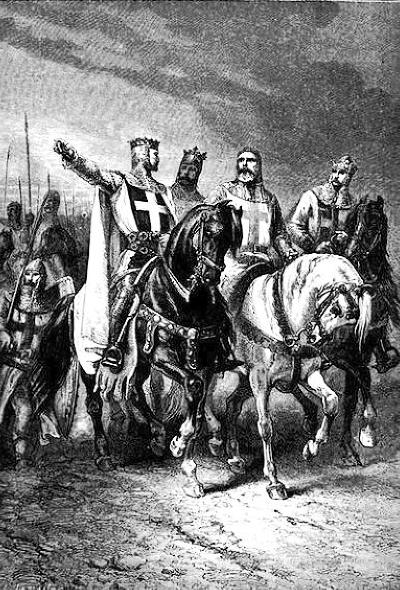
Leaders of the first Crusade – Godfrey de Bouillon, Raymond de Toulouse,
Bohemond de Tarento and Tancred d’Hauteville.
– by Gustav Dore (French artist, 1832-1883)
A final decisive battle between the Crusaders and the Egyptian Fatimid forces was held near Ashkelon on the south. The Crusader victory (August 14, 1099), which effectively used their cavalry to surprise the enemy, sealed their possession of the Holy Land for the following 200 years.
-
Ayyubid dynasty (1187-1250)
The Ayyubid dynasty was founded by Saladin, who defeated the Crusaders and captured Jerusalem (1187). The tower was destroyed by the Ayyubid ruler Al-Malak al-Ma’atam Isa in 1219, when the walls of the city were leveled. The destruction of the walls was a result of their fear that the Crusaders will return and capture the city. Indeed, the Crusaders returned to rule the city for a short time (1229-1244) following the fifth Crusade.
According to the archaeologists, the walls and tower were rebuilt during the end of the period of the Ayyubid dynasty, prior to the Mameluke period (1250-1517).
-
Ottoman period (1517-1920)
The walls were rebuilt again by the Ottoman ruler Suleiman the Magnificent (in 1538), following the Ayyubid course. These are the current walls of the old city of Jerusalem.
-
Modern period
An archaeological excavation, headed by Dan Bahat and Menashe Ben-Ari, was conducted here in the years 1971-1972 following the reunification of the city in 1967. A conservation work was held here in 2007-2008, as part of the Zahal (IDF) plaza renovation project.
A small section of the walls of the fortress are visible on the external side of the old city walls. The majority of its remains are buried under the Catholic school Collège des Frères on the other side of the wall.
Photos:
(a) General view
A small section of the remains of the Tancred fortress is located on the west side of the old city wall, near the Zahal (IDF) plaza. There are few remains of the Crusader period, when a large fortress was located in this north west corner of the city. Above its remains are the Ottoman period walls.
Click on the photos to view in higher resolution…
The next photo shows a closer view of this section.
On the right side (east) is the old city wall, which is built above the Crusader era wall. This was the western side of the fortress, which extended beyond the wall.
On the left (west) side is a dry moat which was part of the fortifications.
(b) Moat
A western view towards the Zahal plaza and the old hospital is seen in the next photo, with another view of the moat. The purpose of the dry moat (the deep, broad ditch) was a first line of defense – keeping the battering ram and other siege weapons away from the wall. This moat is 19m wide, with a depth of 7 meters.
Note that in Europe the moat was usually filled with water, but in Jerusalem the dry climate could not support a wet moat.
(c) Foundations of the tower
The Tancred/Goliath tower measures 35 meters square, but only traces of its foundations can be seen on the external side of the city walls, which were built in the 16th Century.
As seen here, the foundations of the tower protrudes 3 meters from the line of the wall.
This visible section is built of stones dated to the Herodian period, probably dismantled from the Psephinus Tower, which was on the corner of the third wall and destroyed in the great revolt.
A closer section of the base of the fortress is seen in the next photo.
(d) Outer wall
The tower was protected by a second external wall, which extended 3m beyond the inner wall. The modern paved walkway is located between the walls, and was part of the conservation project in this area.
This external wall, also 3m wide, is seen on the edge of the moat, beyond the modern fence.
The southern side of this external wall is seen in the following photo:

This plan is similar to plan of another Crusader era fortifications – the tower of David, located in the Jaffa gate. It also has a moat in front, an external wall above the moat, and an internal wall of the high tower.
(e) Ayyubid period
According to the archaeologists, the walls and tower were rebuilt during the end of the period of the Ayyubid dynasty (1244-1260), prior to the Mamluke period.
On the south side of the tower are remains of an aqueduct, dated to the Ayyubid period.
Etymology:
- Tancred fortress – named after the Crusader prince who fought here in 1099
- Goliath fortress – the Arab name of the tower
- Burj Jalud – Arabic name of the fortress (Burg-tower, Jalud-Goliath), named after a legend that here David killed Goliath
- Qasr Jalud – Another Arabic name of the site (Qasr-fortress)
- Caliph – Arabic for ruler, based on the word khilafa – succession (similar to the Hebrew word Chalifi – substitute)
- Caliphate – Islamic state ruled by supreme religious and political leader known as the Caliph
- Zahal – Hebrew initials for IDF – Israeli Defense Forces
Links:
- Conservation of Zahal plaza (IAA, 2007-2008)
- Conservation of Jerusalem walls (Hebrew, IAA, with a good diagram of the excavations); a short English version is also available
- Gustav Dore – illustrations of the Crusaders (Wikimedia, Dan Short)
- Jerusalem architecture – book by D. Kroyanker (Hebrew)
References:
- Bahat D. and Ben-Ari M. 1972. Excavations in Zahal Square. Qadmoniot V. pp 19-20, 118-119 (Hebrew).
- Yad Ben Zvi – In the paths of the Crusaders – the tour was conducted by Dov Notkovich on May 23, 2014
BibleWalks.com – navigate with the Bible
Jerusalem Videos <<<—previous Jerusalem site–<<< All Sites >>>—>>>Ramat Rachel
This page was last updated on June 27, 2014
Sponsored links:
